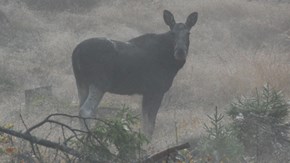
To be able to identify research priorities, information on wildlife health and diseases is collected continuously, primarily through passive surveillance. This is achieved by following reports of sick or dead wildlife submitted by the public throughout Sweden, performing post-mortem examinations on reported cases and by keeping up to date with infectious diseases in wildlife in other countries. Wild fish and shellfish often live in close contact with farmed fish in open cages posing a risk for transmission of diseases in both directions.
Research targeted at specific infectous agents or pathogens
There are a variety of infectious agents that infect wildlife and can cause disease of variable severity. In addition to their effect on individual animals, some pathogens can impact the entire wildlife population. Certain pathogens can infect multiple wildlife species, helping the pathogen to persist and spread within an ecosystem. A pathogen may also have been recently introduced into the country, a new area or in a new wildlife species. It is often under these circumstances that research is of greatest interest.
Contact us
Erik Ågren and Aleksija Neimanis, veterinary officers